John McGonigle Oileán H-B1 Triple Calendar Chronograph: I Don’t Know Of A More Beautiful Complicated Movement Available For The Money
by Ian Skellern
The word “Ireland” might inspire images of verdant land, creamy dark Guinness, lucky shamrocks, and mischievous leprechauns, but few are likely to associate the country with fine watchmaking.
Even when Irish watchmakers John and Stephen McGonigle launched their own brand McGonigle Watches back in 2006, it was (and still is) based in Switzerland where the brothers trained and honed their skills working on complications for prestigious Swiss brands.
I first met brothers John and Stephen at Baselworld 2006, and at the end of the day suggested to John that we grab a beer (or two) and I interview him for an article in iW magazine. He came across as fairly relaxed during the day, but as I started the interview he seem to grow increasingly nervous and stressed. I asked him if anything was wrong and he replied that it was just that it was his first time being interviewed by a real journalist. I laughed and replied that that was my first time being called a real journalist.
McGonigle Watches grew successfully, especially after the launch of the Tuscar in 2010, which featured the brothers’ first in-house movement. However, with Stephen living in Switzerland and John in Ireland the logistics of working together (even pre-COVID-19) led the brothers to amicably split. In 2020 John launched his own brand Oileán (pronounced il-awn), which is Gaelic for “island.”
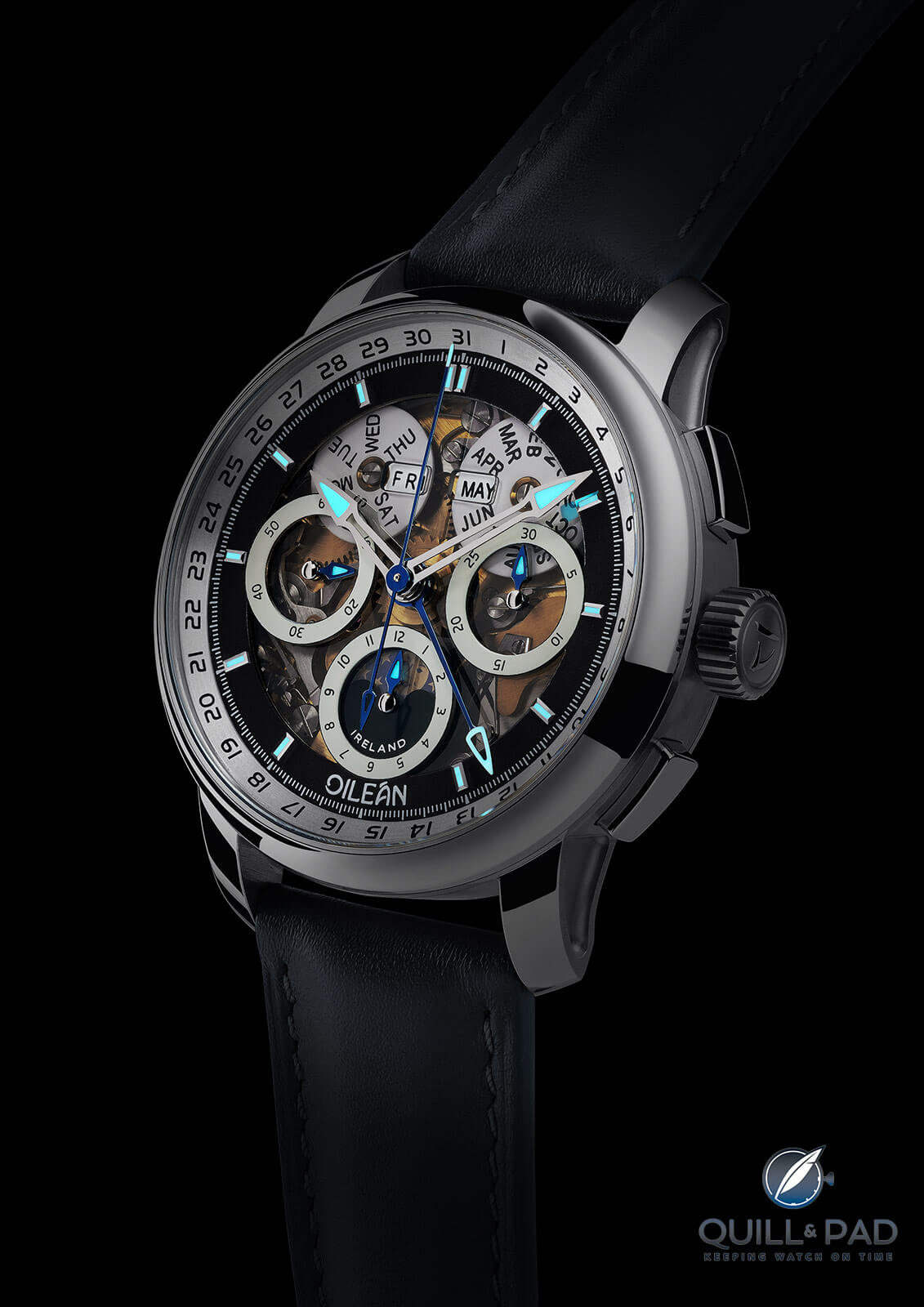
Oileán H-B1 Triple Calendar Chronograph with visible lume
While perhaps better known for making contemporary watches, John is one of the best watch restorers I know and his hand finishing is second to none. So for Oileán he decided that he would make watches that enabled the movements to take center stage.
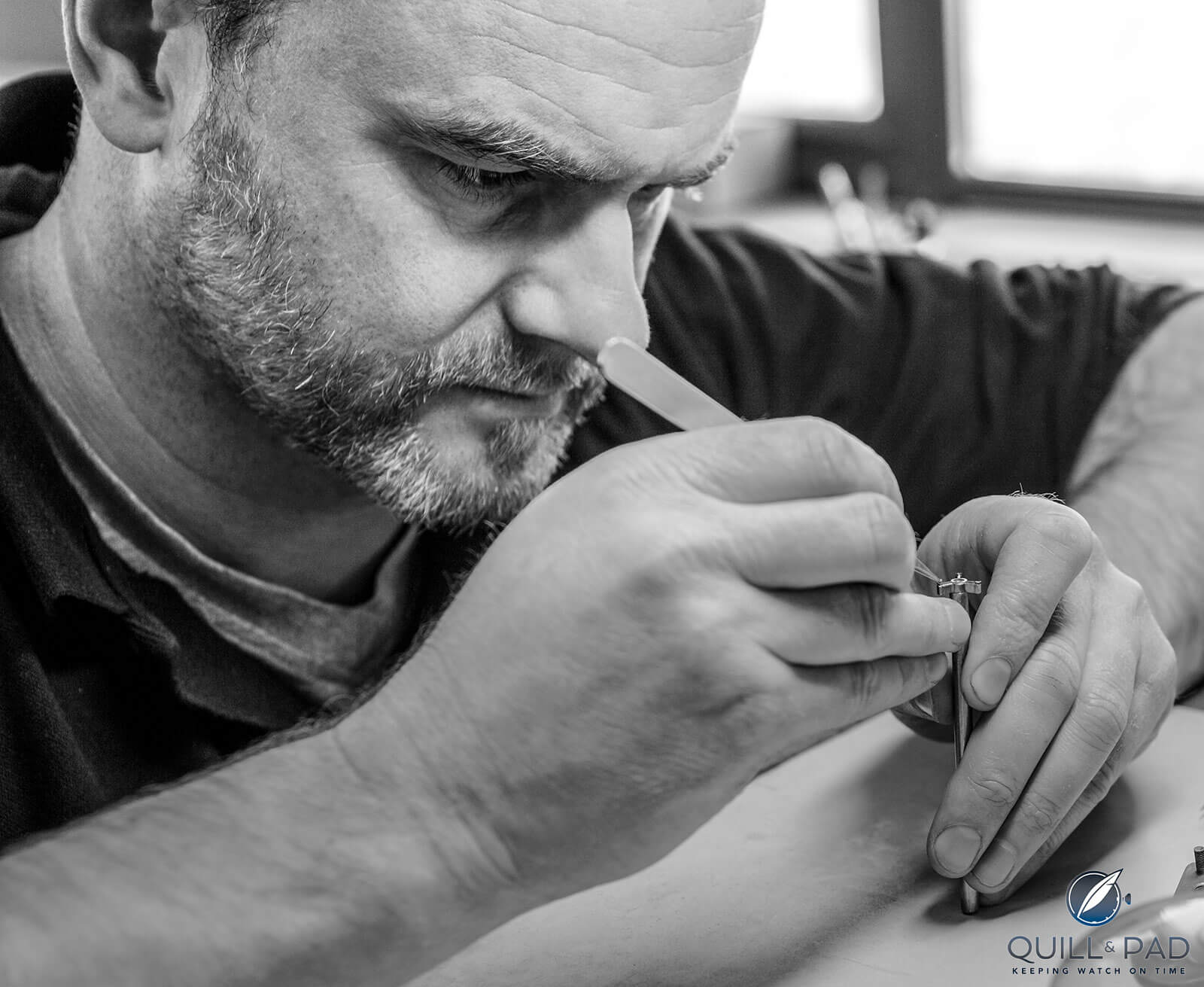
John McGonigle at his bench
Oileán H-B1: movement
John McGonigle’s first watch is the Oileán H-B1, a triple-calendar column wheel chronograph powered by a highly modified new-old stock Valjoux 88 movement.
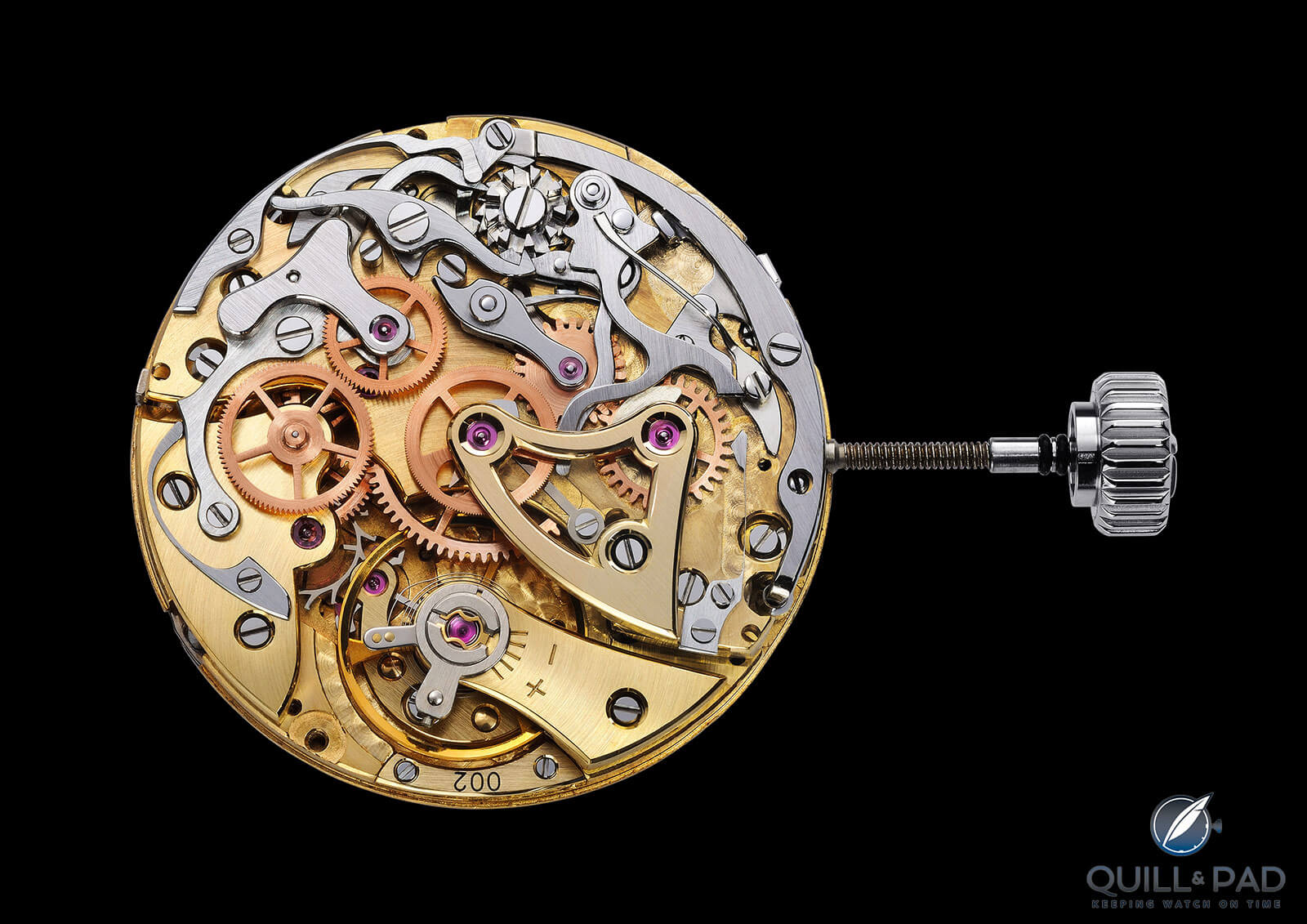
Back of the movement of the Oileán H-B1 Triple Calendar Chronograph
“Modified” doesn’t do justice to what McGonigle has done to this legendary chronograph movement, though. He has superlatively polished all components to reduce friction, thinned the springs so that they operate more smoothly and efficiently, straight grained the flat steel, and beveled and mirror-polished all screw heads.
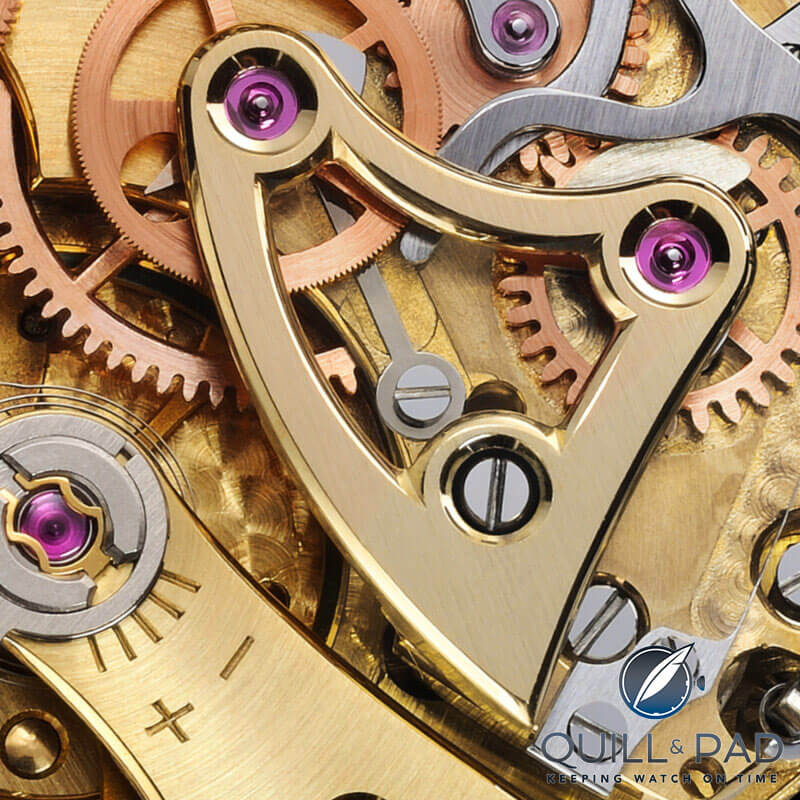
McGonigle Oileán H-B1 Triple Calendar Chronograph movement detail
McGonicle also replaced many of the original copper-beryllium and brass components with steel parts, both to maximize the life of the movement and to enable a much higher level of hand finishing. And if that wasn’t enough, McGonigle also replaced a couple of bridges with those of his own design.
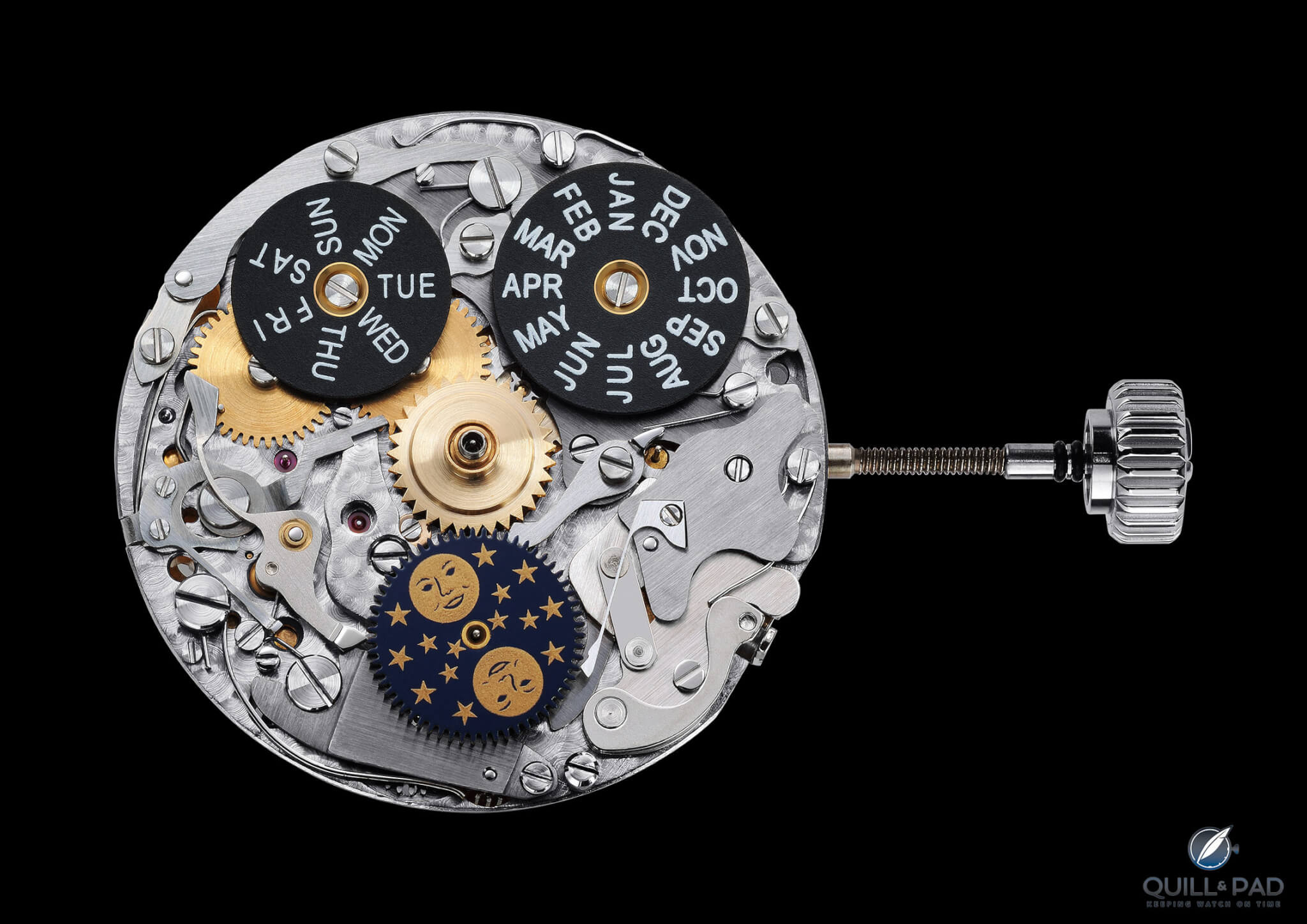
Top of the movement of the Oileán H-B1 Triple Calendar Chronograph
While the transparent, slightly smoked sapphire crystal dial offers tantalizing views to the top of the movement, the view through the display back is simply breathtaking.
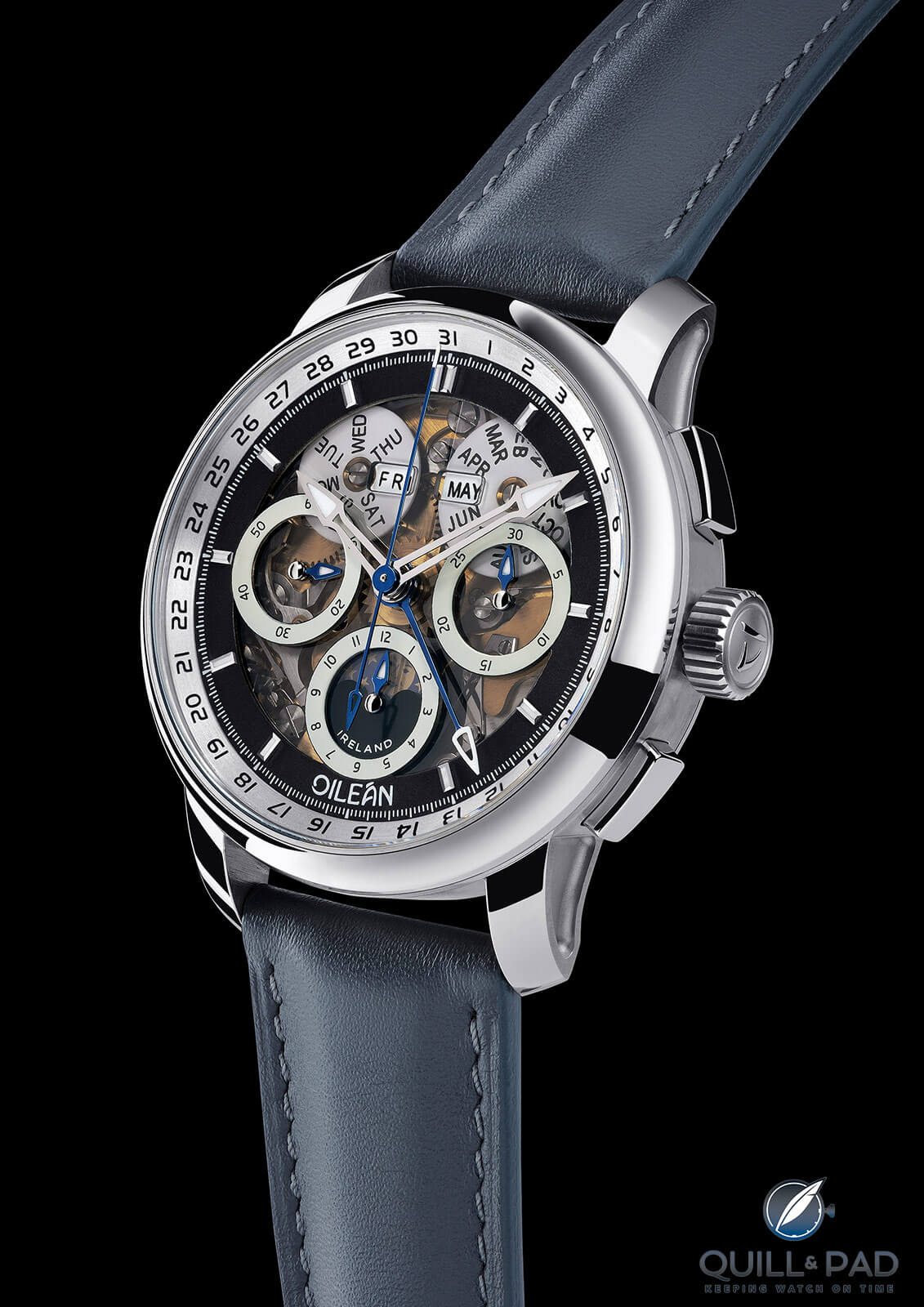
Oileán H-B1 Triple Calendar Chronograph
Oileán H-B1: dial and indications
Not surprisingly for a triple calendar chronograph, there is a lot going on dial side of the H-B1. The time is displayed by central hours and minutes via skeletonized hands with cool blue Super-LumiNova-filled arrow tips. Small seconds are in a subdial at 9 o’clock.
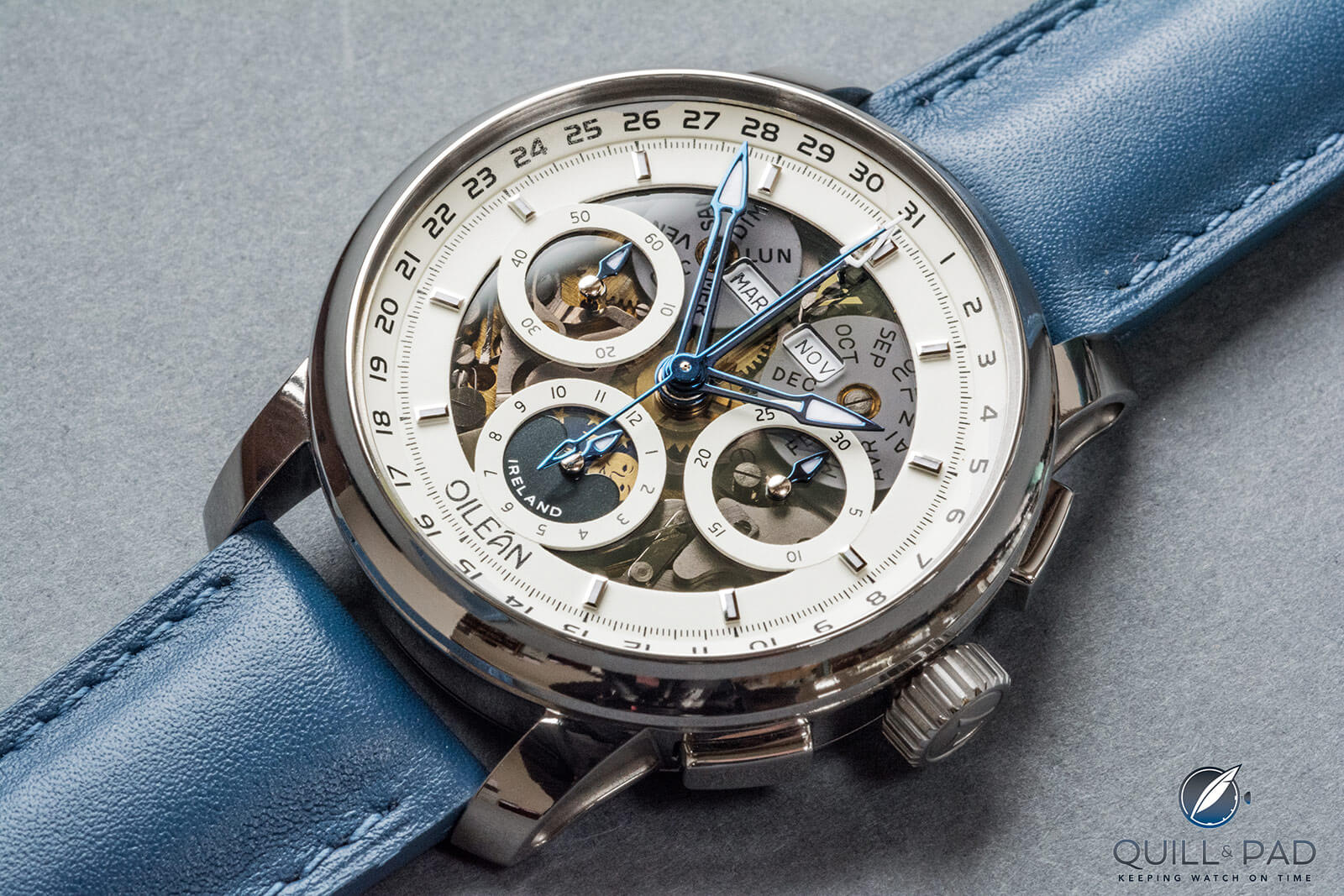
Oileán H-B1 Triple Calendar Chronograph by John McGonigle
The triple calendar functions include the day at 11 o’clock and the month at 1 o’clock, while the date is displayed by a central arrow-tipped, heat-blued hand around the periphery of the dial. There’s also a moon phase indicator (because why not?) within the chronograph’s 12-hour totalizer at 6 o’clock.
The chronograph features a 30-minute counter at 3 o’clock, 12-hour counter at 6 o’clock (with “Ireland” at the bottom), and an elegantly slim, central, blued elapsed second hand with luminous tip at one end and an arrowhead counterweight at the other.
Clients have the options of either white or black for the day and month disks as well as having the main plate and bridges either rhodium- or gold-plated.
Oileán H-B1: case
The case, a very wearable 40 mm in diameter, is in lightweight Grade 5 titanium. But the triple calendar module does bump up the thickness to a chunky 14.2 mm. This isn’t a discreet under-the-cuff dress watch – well, not unless you have big cuffs.
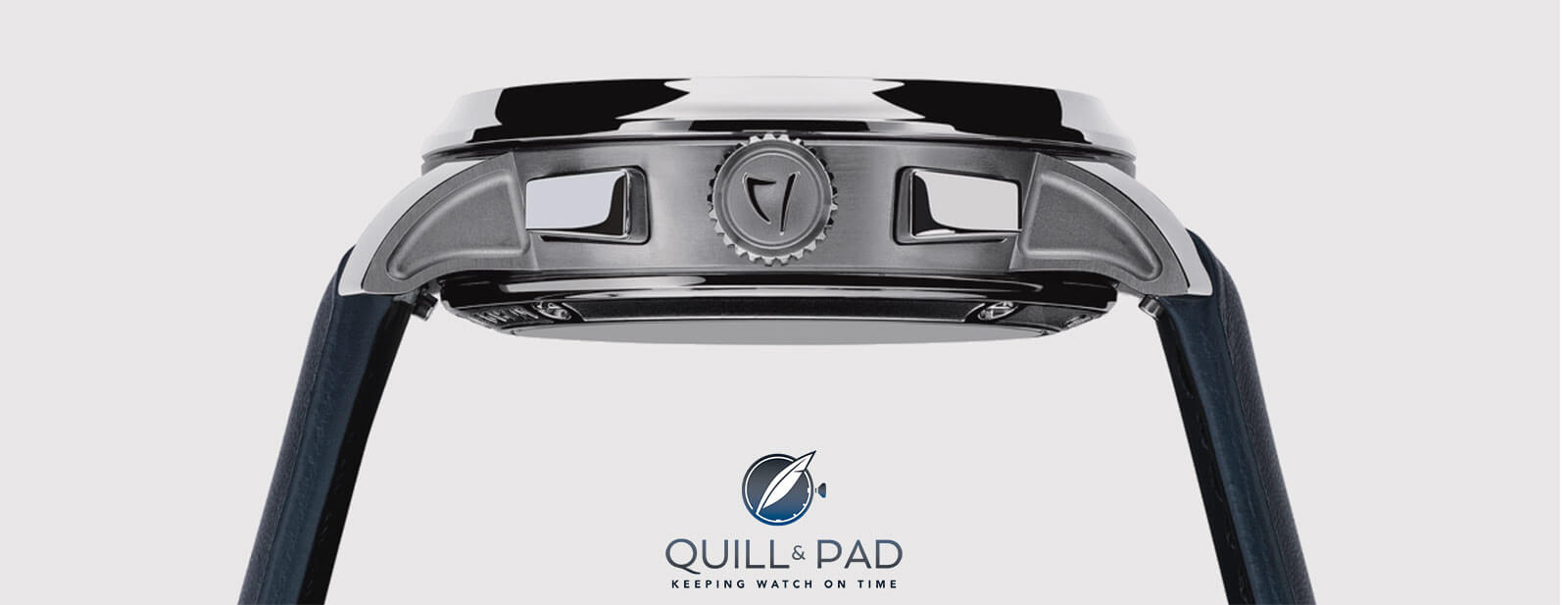
McGonigle Oileán H-B1 Triple Calendar Chronograph in profile
The highly polished titanium chronograph pushers are on either side of the crown featuring an engraved Oileán harp logo (the harp being one of Ireland’s national hallmarks). On the other side of the case band are two flush corrector pushers for the calendar indications.
Conclusion
McGonigle’s aim was to highlight the movement with the best traditional watchmaking techniques and hand finishing. He has accomplished that superbly as virtually all of the sensationally finished movement is open to view either through the sapphire crystal dial or display back. While not a limited edition, he is limiting production to just eight pieces a year, and not surprisingly already has a backlog of orders.
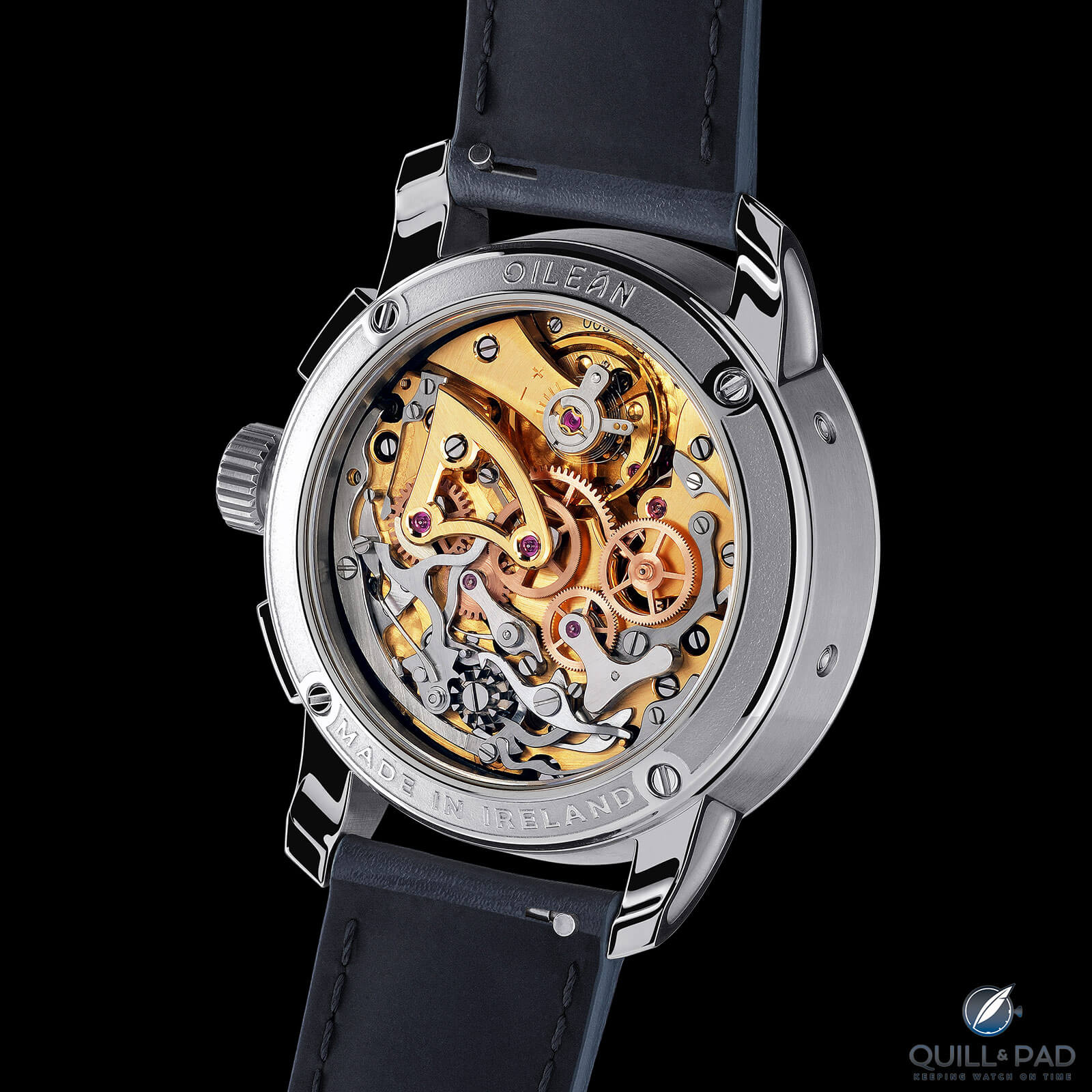
Back of the Oileán H-B1 Triple Calendar Chronograph
The Oileán H-B1 is a watch for movement geeks (like me) and while at €23,500 (before taxes) it certainly isn’t cheap, it’s the best value-for-money, exquisitely hand-finished, complicated watch I’ve ever seen.
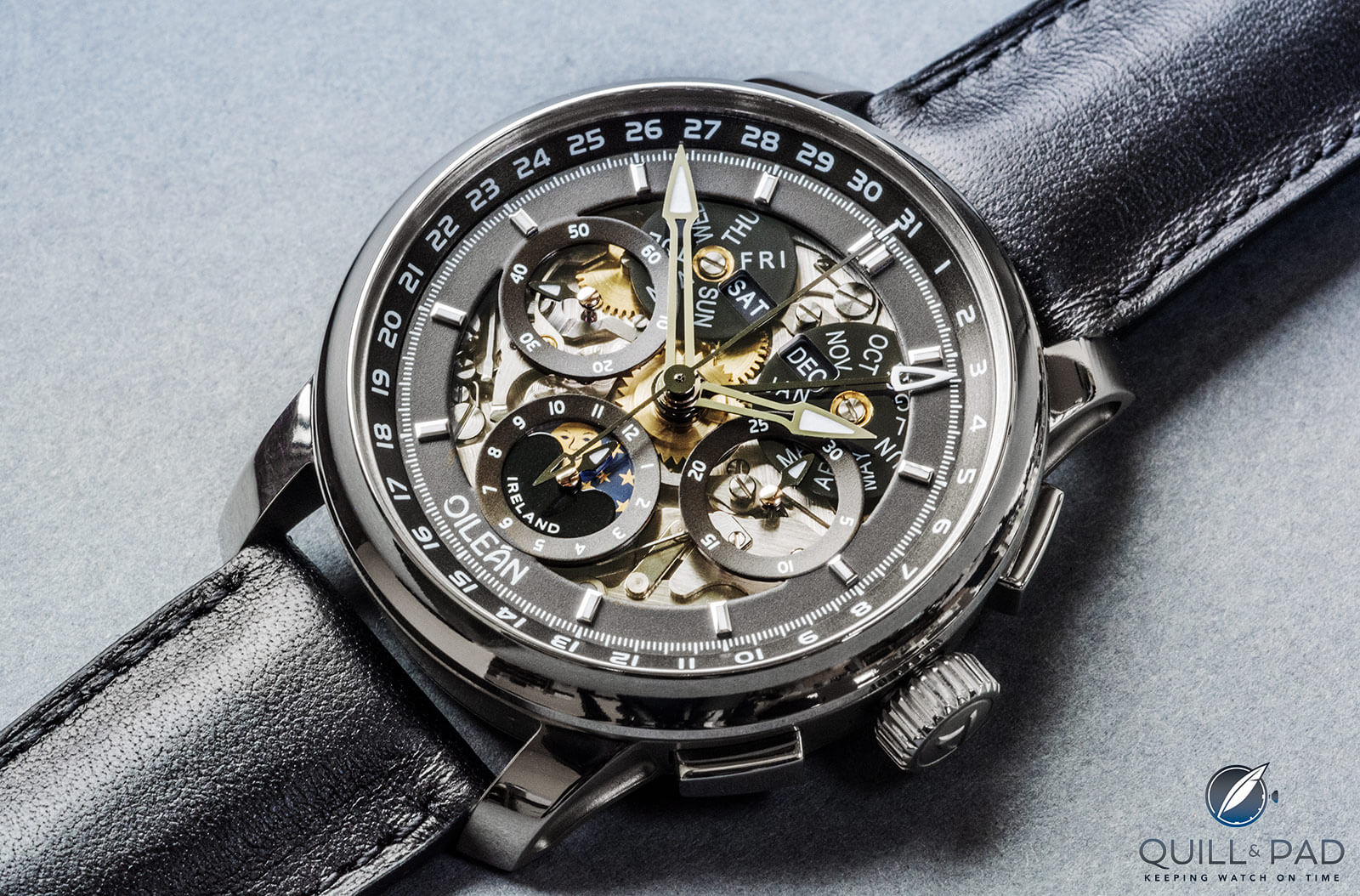
Oileán H-B1 Triple Calendar Chronograph by John McGonigle
For more information, please visit www.oilean.watch.
Quick Facts Oileán H-B1
Case: 40 x 14.2 mm, Grade 5 titanium with display back, water resistance 30 m
Dial: transparent smoked sapphire crystal
Movement: hand-wound modified Valjoux 88 with triple calendar, 3 Hz/21,600 vph frequency, power reserve 40 hours
Functions: hours, minutes, small seconds; date, day, month, moon phase; chronograph
Strap: leather with titanium pin buckle
Limitation: 8 pieces per year
Price: €23,500 (excluding taxes)
You may also enjoy:
Behind The Lens: McGonigle Tuscar One Of Ten
Interconnectivity And Independence: The McGonigle Tuscar
Why I Bought It: Ming Watches Model 17.06 Monolith
Behind The Lens: Two Unique Masterpiece II Chronographs From Kari Voutilainen
Leave a Reply
Want to join the discussion?Feel free to contribute!



Skeletonised dials are a thumbs down for me. Really not good looking.
23,500 Euros? One pick up a Valjoux 72c or 88 watch in excellent condition for one-tenth that
Well,If that’s how you feel, I suggest a much deeper dive into understanding the horological landscape is in order.
Also, he did not add the triple calendar as the Valjoux 88 always had that complication and moonphase
Thanks for noting that, Craig, I will edit.
Regards, Ian
You can buy a Valjoux 88 much cheaper, Craig, if it’s just a basic movement you want, but what John has done is transform the duck into a swan. That’s like saying a Skoda Superb is the equivalent to an Audi A6 because most of the underlying mechanics are similar. Horses for courses.
Regards, Ian
I somewhat agree with you Albert about disliking skeletonized dials but the Oileán H-B1 Chronograph watch does it justice with an easily legible dial which includes the beauty of a Triple Calendar along with a Moon Phase indicator! The dial is busy but clearly legible. In my opinion this limited, hand finished watch is a definite keeper.
What I don’t understand is why a watch that uses a movement at 3hz – – – yes I understand that it has been modified – – – – costs so much more than a watch that uses a movement that works at 4hz, not only that but this watch and other very expensive watches that use a 3hz movement don’t even have the same power reserve as others that give 80 hours.
I think that some watch manufacturers are ripping people off.
The 3hz verse 4hz debate has gone on for years with no right answer for which is best. The level of craftsmen ship has more to do with “better” not the beat speed. I’m not just speaking of the level of finishes or materials used (which do effect price) but how well the movement is designed and assembled. You can get watches in all price ranges with slow and fast movements. And if I’m reading your power reserve comment correct you saying 3hz has less? If so that is not correct, by default a slower beating movement has more power reserve. The true regulator of reserve is how much power is stored in the barrel do to the size of it or the amount of them.
Hi Scott, the Valjoux 88 is a new-old-stock vintage movement and usually have 2.5Hz balances. Modern movements tend to have 4Hz balances as they are smaller and more accurate, but the higher frequency has the disadvantage of increased wear and a (all else being equal) lower power reserve. 2.5Hz and 3Hz balances are considered more traditional and many appreciate a slower beating larger balance wheel.
It’s worth noting that Greubel Forsey, whose watches cost hundreds of thousands of dollars generally have 3Hz balances.
Regards, Ian
You can almost see the dial well enough to tell what time it is
Thanks for a thorough review, Ian, and for your educated impressions.
It never ceases to surprise me that some of those who are sufficiently interested to read and comment upon these articles express views which can most kindly be described as naive. That’s a lot of watch, a lot of skill and a lot of labour for the money. See how far the same money might go buying a bland, mass-produced and mass-marketed chrono churned out in the tens or hundreds of thousands by the machines of the bucket-shop brands!
‘Chapeau’ to John for re-imagining a piece of watchmaking history.
Cheers,
pplater.
And hat to you my friend, hat to you. Just kidding I knew what you meant. lol
To me, just a normal guy who likes watches, this is a nice $10,000 watch you are welcome to 23k for. That makes it better than most in the Veblen goods space, you are usual asked to pay 10k for a $500 watch, So I guess, this is net good ?